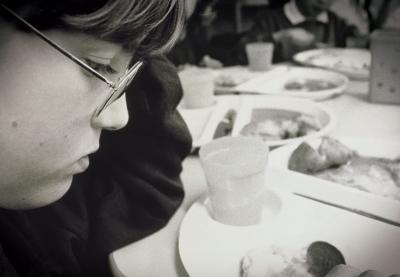Last fall, I got the chance to do something most folks my age never do.
I got the chance to go back to high school, back to the high school cafeteria, to be exact.
It wasn't my high school. In fact, it was hundreds of miles away from my alma mater. But sitting there, at those long tables, perched on those small round seats amid the sound of hundreds of chattering voices and squeaky lunch trays, I was instantly transported back to memories of my own high school days.
Only this time I wasn't a student, just an adult with a job to do.
My trip back to the high school cafeteria was actually part of a reporting assignment. I was covering the school's participation in Mix It Up at Lunch Day, a program that asks students to step out of their comfort zones and take new seats at lunch as a first step toward questioning the social boundaries that divide and define us.
What I saw and heard at this school disturbed and saddened me. As I sat among the students, I kept asking myself: "Could I have been this exclusionary, this cliquish, this intolerant of others?"
What I saw that day made me worry about how my own 7-year-old son will be treated as he gets older, when those unwritten rules of friendship and socialization become clearer — those rules that tell us to stick with our own kind, stay in our own circle and shy away from difference and diversity.
And worse, it made me worry about how he might treat others.
Reluctance, fear and isolation
That day, students were supposed to forgo their usual seating habits, sitting instead at tables labeled by birth month. But very few students participated.
Making my way from table to table, I captured comments from dozens of students who shared their reasons for not swapping seats.
At a table of Spanish-speaking students in the back of the lunchroom, one girl explained that she had no desire to sit with students who called her and her friends "beaners" and "spics" every day.
At the table for July birthdays, a student with a developmental disability ate french fries alone because no one chose to join him. Pointing to the corner where he normally sat, he told me he missed his friends.
At the Goths' table near the back of the lunchroom, one student told me she didn't want to risk sitting down beside classmates who routinely called her "devil worshipper" because of her Pagan beliefs.
During the three lunch periods, I jotted down one tale of reluctance, fear and isolation after another.
Amid it all, I kept thinking about my son, visualizing him at the round table in his 1st-grade classroom, swinging his feet just above the floor and swapping sandwiches and stories with any classmate who would listen.
I was unnerved, wondering if the cruelty I'd just witnessed was a glimpse of what he might face a few years from now.
Navigating boundaries
As much as children learn about navigating social boundaries at school, it's what we as parents teach them at home that truly guides their interactions with others.
These aren't one-time lessons or isolated conversations. They are part of an ongoing process that includes regular dialogue about tolerance, compassion and respect for differences.
I wonder about the conversations that did or didn't happen in the homes of the high school students I met last fall.
Did the parents of children with July birthdays know their sons and daughters let a classmate with a developmental disability sit alone? How many parents knew their children were routinely being called "beaners," "spics" or "devil worshippers?" How many parents knew their children were so isolated at school that they were afraid to take a different seat at lunch even for one day?
This year, Mix It Up at Lunch Day is November 16. Thousands of schools across the country will participate. Help your child get involved and use the event as a springboard to discuss the social boundaries that impact your child's life.
Here are some questions to get you started:
- What are the social groups or cliques at your school?
- What do these groups say about themselves? What do others say about them?
- Is there a group that you most identify with? Why?
- How do the different groups get along with each other?
- Are the different groups treated equally? Do they all have the same chance to receive school resources, participate in activities or use school facilities or space?
- What would happen if the groups at your school mixed it up? What might keep the groups from wanting to mix it up?
Since my trip back to high school last fall, I've taken a deeper interest in what's happening during my son's school day — not just the grade on the spelling test or the math quiz, but the social things, too. The playground, the lunchroom, the hallway between classes.
I hope these conversations will guide him as he gets older and teach him that it's OK to cross the boundaries he'll encounter.
But more importantly, through these conversations, I hope to encourage him to always be the one who opens his arms and mind to new people and new experiences, the one who's not afraid to stand out from the crowd and stand up for others.
And so I picture him several years from now — a well-rounded, compassionate, high school student, still swapping sandwiches and stories with anyone who will listen.


0 COMMENTS